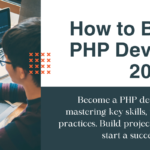Introduction
Have you ever felt the thrill of creating your first login form? Or the satisfaction of designing your first web page layout? The journey of a web developer is filled with challenges, but seeing your website live and functional makes it all worthwhile. With technology evolving rapidly, staying ahead in the field of web development requires constant learning.
If you want to become a Full Stack Web Developer in 2025, this guide will walk you through the essential skills and tools you need.

Who is a Full Stack Web Developer?
A Full Stack Web Developer is someone who can handle both frontend and backend development. They work with various technologies like HTML, CSS, JavaScript, React, Angular, Node.js, Django, and databases like MySQL and MongoDB. These professionals create dynamic, responsive, and efficient web applications, handling everything from user interfaces to data management.
Steps to Become a Full Stack Web Developer in 2025
1. Learn Frontend Development
Frontend development is about building the part of the website users interact with. It involves three core technologies:
a) HTML (HyperText Markup Language)
HTML provides the structure of web pages. Start with the basics and explore:
- HTML Tags
- Attributes
- Forms and Tables
- Semantic HTML
b) CSS (Cascading Style Sheets)
CSS makes web pages visually appealing and responsive. Learn:
- Colors and Borders
- Box Model and Layouts
- Flexbox and Grid
- CSS Frameworks (Bootstrap, Tailwind CSS)
c) JavaScript
JavaScript adds interactivity to web pages. Master:
- JS Fundamentals (Variables, Functions, Loops)
- DOM Manipulation
- Event Handling
- JavaScript Modules
d) Frontend Frameworks
Using frameworks can speed up development. Consider learning:
- React – Most popular and beginner-friendly
- Vue.js – Simple and efficient
- Angular – Great for large-scale applications
- Svelte – Gaining popularity for lightweight applications
2. Learn Backend Development
Backend development manages server-side logic, databases, and APIs.
a) Choose a Backend Language
Pick at least one server-side language:
- Node.js (JavaScript)
- Python (Django, Flask)
- Java (Spring Boot)
- PHP (Laravel, CodeIgniter)
- Ruby (Ruby on Rails)
b) Learn a Backend Framework
Frameworks simplify backend development. Choose one based on your preferred language:
- Express.js (Node.js)
- Django (Python)
- Spring Boot (Java)
- ASP.NET (C#)
c) Work with Databases
Most web applications need a database. Learn:
- Relational Databases (MySQL, PostgreSQL)
- NoSQL Databases (MongoDB, Firebase)
- Caching & Lightweight DBs (Redis, SQLite)
3. Version Control with Git
Git helps track changes in code. Learn how to use:
- Git Commands (commit, push, pull, merge)
- GitHub/GitLab for collaboration
4. Testing Your Code
Testing ensures your application runs smoothly. Explore:
- Unit Testing (Jest, Mocha for JavaScript, PyTest for Python)
- Integration Testing
- End-to-End Testing
5. Deployment & DevOps
Hosting a web app requires knowledge of deployment. Learn about:
- Hosting Platforms (Heroku, AWS, DigitalOcean)
- Web Servers (NGINX, Apache)
- Containers (Docker, Kubernetes)
- Continuous Integration/Deployment (Jenkins, Travis CI)
Conclusion
Becoming a Full Stack Web Developer in 2025 requires learning multiple technologies. Focus on:
- A strong foundation in frontend and backend development
- Hands-on practice with real projects
- Continuous learning and staying updated with industry trends
Choose a learning path that suits you and start building projects. Whether you aim for a job or freelancing, mastering full-stack development opens endless opportunities!
FAQ
1. How long does it take to become a Full Stack Developer?
It depends on your learning speed. With consistent practice, you can become job-ready in 6–12 months.
2. Do I need a degree to become a Full Stack Developer?
No, but a degree in Computer Science helps. Many developers learn through online courses, bootcamps, and self-study.
3. Which is the best programming language for Full Stack Development?
JavaScript (Node.js) is popular for full-stack development, but Python, Java, and PHP are also widely used.
4. What projects should I build to practice?
Start with basic projects like a to-do list, portfolio website, or blog. Then, move to complex applications like e-commerce platforms or social media apps.
Start your journey today and become a Full Stack Web Developer in 2025!
That’s a wrap!
Thank you for taking the time to read this article. I hope you found it informative and enjoyable. If you did, please consider sharing it with your friends and followers. Your support helps me continue creating content like this!
Thanks!
Kamal Pankaj😊



l hope education